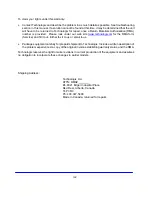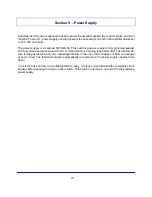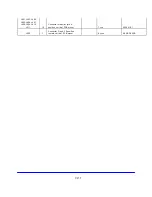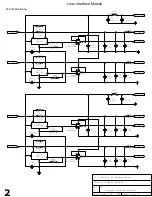
VI-1
Section VI – Monitor and Control System
Control System Overview (Insight)
The Insight control system is used for a variety of functions, the most important of which is ensuring
that the transmitter continues to operate in a safe manner. The control system also allows the user
to monitor and control the transmitter from both the front panel and the remote access port.
Five modules comprise the Insight control system. These modules work together to provide all the
functions of the control system. The modules are: the user interface module, the coupler condition
module, the RF conditioning module, the temperature sensor module, and the TxNET module. The
operation of each module is outlined in the following sections.
User Interface Module
The primary function of the user interface module is, as the name suggests, providing the user
interface for the control system. This circuit board is mounted to the front panel of the transmitter,
directly behind the LCD display. The membrane switch on the front panel is also connected to the
user interface module. These components together provide the user with the ability to monitor the
transmitter from the front panel.
The following parameters can be monitored from the front panel:
•
Forward (incident) power at the transmitter output.
•
Reflected (reverse) power at the transmitter output.
•
DC voltage of the transmitter power supply.
•
DC current for each pallet in the transmitter.
•
Temperature of the heat sink of the transmitter.
•
The time since the transmitter was last shut down.
The hardware of the user interface module is based around a microcontroller (U112). This
microcontroller interfaces directly with the LCD and the membrane switch to provide output and
receive input from the user. The microcontroller also communicates with the coupler conditioning
board over a controller area network (CAN) bus. This communication is facilitated be two ICs, U113
and U114, and passes through a CAT5 cable attached to connector J105. The communication link
with the coupler conditioning module allows the user interface module to receive information about
the foreword power, reflected power, and temperature of the transmitter, as well as relay
commands from the user to the rest of the system. If the transmitter includes more than on
amplifier module, a second CAN connection will be present between the user interface module
(J106) and the TxNET board to facilitate communication between enclosures.
Other elements of the user interface module are also controlled by the microcontroller. A buzzer
(BZ101), a status LED (D113), and a relay to control the backlight of the LCD (RL101), are all
controlled through a buffer (U116). In order for the user interface module to monitor the current
draw of each pallet in the system, the DC supply wires pass through the user interface module on
their way from the power supply to the pallets. The DC enters through connector J101 from the
power supply, and exits through J102 to go to the pallets. As the current passes through shunt
resistors (R117, R118, R120, R121, R123, R124, R126, R127, R129, R130), the voltage drop is
Summary of Contents for TAUD-40
Page 1: ...TAUD 40 POWER AMPLIFIER NEW ADVENTURES IN BROADCASTING Technalogix...
Page 17: ......
Page 18: ......
















































